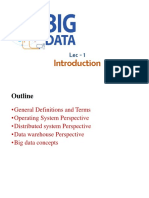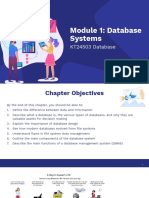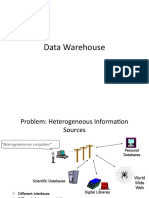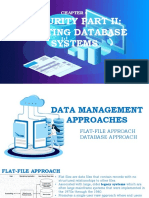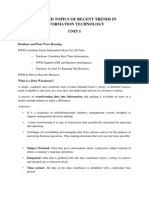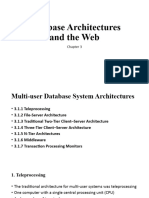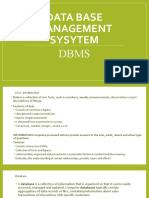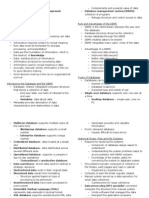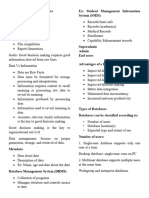Data Keying Error Reduction Reduction of Paper Postage Automated Procedures Inventory Reduction
Data Keying Error Reduction Reduction of Paper Postage Automated Procedures Inventory Reduction
Uploaded by
Bianca QuiambaoCopyright:
Data Keying Error Reduction Reduction of Paper Postage Automated Procedures Inventory Reduction
Data Keying Error Reduction Reduction of Paper Postage Automated Procedures Inventory Reduction
Uploaded by
Bianca QuiambaoOriginal Description:
Original Title
Copyright
Share this document
Did you find this document useful?
Is this content inappropriate?
Copyright:
Data Keying Error Reduction Reduction of Paper Postage Automated Procedures Inventory Reduction
Data Keying Error Reduction Reduction of Paper Postage Automated Procedures Inventory Reduction
Uploaded by
Bianca QuiambaoCopyright:
ELECTRONIC DATA INTERCHANGE -When we group together the data attributes that logically
- To coordinate sales and production operations and to define an entity, they form a record type.
maintain an uninterrupted flow of raw materials, many • Database
organizations enter into a trading partner agreement with -Set of record types that an organization needs to support
their suppliers and customers its business processes
Enterprise Resource Planning • Association
- An example of EDI -Record types that constitute a database exist in relation to
- Use to help managing and integrate the core other record types.
of the business operation. -One-to-one association, one-to-many association, and
Functional Group many-to-many association
- is a collection of transaction sets (electronic documents)
for a particular business application, such as a group of • One-to-one association
sales invoices or purchase orders. The transaction set is -For every occurrence in one Record Type, there is one (or
composed of data segments and data elements. possibly zero) occurrence in other Record Type.
Important features of EDI • One-to-many association
• EDI is an inter-organization endeavor. -For every occurrence in one Record Type, there are zero,
• The information systems of the trading one, or many occurrences in other record type Record
partners automatically process the Type.
transaction.
• Transaction information is transmitted in a • Many-to-many association
standardized format. -For each occurrence of both Record Types, there are zero,
one, or many occurrences in the other Record Type.
EDI STANDARDS • Hierarchical Model
• EDI success is the use of a standard format -Constructed of sets that describe the relationship between
for messaging between dissimilar systems two linked files.
• Example, (ANSI) X.12 format. In US and -Each set contains a parent and a child.
EDIFACT in UK -Files at the same level with the same parent are called
Benefits of EDI siblings.
• Data keying -The highest level in the tree is the root segment, and the
• Error reduction lowest file in a particular branch is called a leaf.
• Reduction of paper -This model is called navigational database.
• Postage -One-to-many association
• Automated procedures
• Inventory reduction Limitations of the Hierarchical Model:
Electronic Fund Transfer A parent record may have one or more child records.
• EFT requires intermediary banks between No child record can have more than one parent.
trading partners.
• EFT requires intermediary banks between Network Model
trading partners. - Like the hierarchical model, the network model is a
navigational database with explicit linkages between
EDI CONTROL records and files. The distinction is that the network model
- The absence of human intervention in the EDI permits a child record to have multiple parents.
process presents a unique twist to traditional control -Many-to-many association.
problems, including ensuring that transactions are • Relational Model
authorized and valid, preventing unauthorized -Portrays data in a two-dimensional table.
access to data files, and maintaining an audit trail of -Across the top of the table are attributes (data fields)
transactions. forming columns.
• Transaction Authorization and Validation -Intersecting the columns to form rows in the table are
• Access Control tuples.
• EDI Audit Trail
Audit Objectives Relating to EDI Databases in a Distributed Environment
• All EDI transactions are authorized, validated, • Centralized
and in compliance with the trading partner • Distributed
agreement Partitioned
• No unauthorized organizations gain access to Replicated
database records
• Authorized trading partners have access only Centralized Database
to approved data -The data is retained in a central location.
• Adequate controls are in place to ensure a -Remote information processing units (IPU) send requests
complete audit for data.
Audit Procedures Relating to EDI -Central site services the needs of the remote IPU.
• Tests of Authorization and Validation
Controls. • Temporary Inconsistency
• Tests of Access Controls. -Values are incorrectly stated.
• Tests of Audit Trail Controls. • Database lockout
-A software control that prevents multiple simultaneous
access to data.
Database and database system
What is database? Distributed Database
is a collection of information that is organized so that it can • Partitioned Database
be easily accessed, managed and updated. -Splits the central database into segments that are
distributed to their primary users.
Database management system • Advantages
special software system that is programmed to know which -Storing data at local sites increases users’ control.
data elements each user is authorized to access. -Improves transaction processing response time.
2 types Database System -Reduce the potential effects of disaster.
Flat-file Model • Deadlock Phenomenon
Database Model -Occurs when there is mutual execution to data and the
transactions are in a wait state.
Flat file model • Deadlock Resolution
Legacy systems (traditional) -Terminating one or more transactions.
Flat files are data files that contain records Factors:
with no structured relationships to other files. – Resources currently invested in the transaction
The flat-file environment promotes a single- – The transaction’s stage of completion.
user view approach to data management – The number of deadlocks associated with the
whereby end users own their data files rather transaction.
than share them with other users. – Replicated database
-Duplication of entire database for multiple
DBMS Models IPUs.
• Data model -Effective for situations with high degree of
-An abstract representation of the data about entities, data sharing but no primary users.
including resources (assets), events (transactions), and -The problem with this approach is
agents (personnel or customers, etc.) and their maintaining current versions of the database
relationships in an organization. at each site.
Database Terminology
• Entity
-A database representation of an individual resource, event,
or agent about which we choose to collect data.
-May be physical or conceptual.
• Data Attribute/Field
-A single item of data, such as customer’s name, account
balance, or address.
• Record Type (Table or File)
You might also like
- Jeffrey A. Hoffer, V. Ramesh, Heikki Topi: Modern Database Management 12 EditionDocument63 pagesJeffrey A. Hoffer, V. Ramesh, Heikki Topi: Modern Database Management 12 EditionAndrew Lin0% (1)
- Element 5.1 Criteria IPD IOSHDocument2 pagesElement 5.1 Criteria IPD IOSHSajid ShahNo ratings yet
- Veritas NetbackupDocument93 pagesVeritas NetbackupKumar Pallav80% (5)
- Candlestick Cheat Sheet RGB FINAL PDFDocument16 pagesCandlestick Cheat Sheet RGB FINAL PDFtebinai50% (4)
- Chapter2 SystemsIntegrationApproachesDocument15 pagesChapter2 SystemsIntegrationApproachesKyla PinedaNo ratings yet
- Lec 1Document76 pagesLec 1Ahmed el-SinousyNo ratings yet
- Chapter 2 Fundamentals of AISDocument7 pagesChapter 2 Fundamentals of AISTHOTslayer 420No ratings yet
- Unit 4: Database Management SystemDocument104 pagesUnit 4: Database Management SystemPoojitha ReddyNo ratings yet
- Week 3 - Database - 2021 T1Document33 pagesWeek 3 - Database - 2021 T1Odria ArshianaNo ratings yet
- 05 Database Management SystemsDocument37 pages05 Database Management Systemsmurtaza aliNo ratings yet
- Introduction To Distributed Data Processing (DDP) : G53DBCDocument4 pagesIntroduction To Distributed Data Processing (DDP) : G53DBCAdityaNo ratings yet
- Database Lecture01rDocument35 pagesDatabase Lecture01rWatanabe KisekiNo ratings yet
- Lecture 2 - DatawarehouseDocument50 pagesLecture 2 - DatawarehousearthurquamenaNo ratings yet
- Data WarehouseDocument73 pagesData WarehouseSweta RanaNo ratings yet
- Lecture4 - DATA WAREHOUSING PDFDocument13 pagesLecture4 - DATA WAREHOUSING PDFAhmad RijalNo ratings yet
- Security Part II: Auditing Database Systems: IT Auditing, Hall, 4eDocument37 pagesSecurity Part II: Auditing Database Systems: IT Auditing, Hall, 4eChelle RaeNo ratings yet
- Database Management System (Using Oracle)Document14 pagesDatabase Management System (Using Oracle)drusilla bagaboNo ratings yet
- Group4 AuditingincisDocument26 pagesGroup4 AuditingincisClarissa Micah VillanuevaNo ratings yet
- Chapter 5 - Database Management Systems: Accounting Information Systems 7eDocument37 pagesChapter 5 - Database Management Systems: Accounting Information Systems 7eMarufjweel KhanNo ratings yet
- Information Technology: Chapter TwoDocument56 pagesInformation Technology: Chapter TwoĒrmias ÁlemayehuNo ratings yet
- UNITyssu 1 LTDocument12 pagesUNITyssu 1 LTSahil KumarNo ratings yet
- (Acyitm1 k33) Group 3 - Collaborative NotesDocument19 pages(Acyitm1 k33) Group 3 - Collaborative NotesHannah Jane ToribioNo ratings yet
- Chapter5_DataWarehouseDocument77 pagesChapter5_DataWarehouseSurya BasnetNo ratings yet
- Csit 217 M2Document50 pagesCsit 217 M2Sanjivani NagNo ratings yet
- Lec 3Document38 pagesLec 3hghauri30No ratings yet
- Data Warehouse ComponentsDocument26 pagesData Warehouse Componentsdurai muruganNo ratings yet
- Data & Information: Chapter-1 1Document48 pagesData & Information: Chapter-1 1Ligo KoshyNo ratings yet
- Chapter 9 - BDMTDocument61 pagesChapter 9 - BDMTFakhrulShahrilEzanieNo ratings yet
- Chapter6_DataWareHousing_finalDocument46 pagesChapter6_DataWareHousing_finaldungm2524003No ratings yet
- RevisionDocument9 pagesRevisionabhayjha30No ratings yet
- First Data WarehouseAima First Final Updated 9 Sep 2016Document188 pagesFirst Data WarehouseAima First Final Updated 9 Sep 2016dineshNo ratings yet
- Data WareHouseDocument48 pagesData WareHouseYoutube CopyrightNo ratings yet
- DB 02Document19 pagesDB 02yangkunbao666No ratings yet
- Data Base Management SysytemDocument26 pagesData Base Management SysytemAkash DeyNo ratings yet
- DWM Unit-IVDocument27 pagesDWM Unit-IVnageshNo ratings yet
- Building Blocks & Trends in Data WarehouseDocument45 pagesBuilding Blocks & Trends in Data WarehouseRaminder CheemaNo ratings yet
- Data and Business Intelligence: Bidgoli, MIS, 10th Edition. © 2021 CengageDocument19 pagesData and Business Intelligence: Bidgoli, MIS, 10th Edition. © 2021 CengageMose MosehNo ratings yet
- AIS Chapter 2 HandoutDocument5 pagesAIS Chapter 2 HandoutElle SalengaNo ratings yet
- Data War Eh PuseDocument51 pagesData War Eh PuseMuneeba HussainNo ratings yet
- Overview of Databases and Transaction ProcessingDocument21 pagesOverview of Databases and Transaction ProcessingAhsan JavedNo ratings yet
- Database NotesDocument81 pagesDatabase NotesEmma mutaurwaNo ratings yet
- DatabaseDocument45 pagesDatabasewaqas08No ratings yet
- 01 Introduction To Databases - 30 1 20 - 1 33 21 - PMDocument4 pages01 Introduction To Databases - 30 1 20 - 1 33 21 - PMdanelozano23No ratings yet
- 4th - Business IntelligenceDocument30 pages4th - Business IntelligenceJoyce Gutierrez JulianoNo ratings yet
- 02 DataWarehousing and OLAPDocument66 pages02 DataWarehousing and OLAPjosephnyangau45No ratings yet
- Database Management Systems (DBMS) Course-KCS-501: Lec 1 - R. S. KohliDocument13 pagesDatabase Management Systems (DBMS) Course-KCS-501: Lec 1 - R. S. KohliRS kohliNo ratings yet
- DM Part 2Document24 pagesDM Part 2madeehaNo ratings yet
- Database Design & ManagementDocument45 pagesDatabase Design & ManagementyohoNo ratings yet
- 1.1 Basic Concepts & ArchitectureDocument27 pages1.1 Basic Concepts & Architecturehareeeee14No ratings yet
- Database Systems Chapter 1Document6 pagesDatabase Systems Chapter 1marlee_musniNo ratings yet
- DW Presentation LogicDocument94 pagesDW Presentation LogicSHREY UPADHYAYANo ratings yet
- Dataware HouseDocument42 pagesDataware HouseTushar100% (8)
- Introduction To Data WarehousingDocument19 pagesIntroduction To Data Warehousingk3333duaNo ratings yet
- DBMS Module1 Part1Document66 pagesDBMS Module1 Part1gauthamNo ratings yet
- Itm 1Document62 pagesItm 1Apoorv PahwaNo ratings yet
- Lec1_Introduction to Database SystemsDocument29 pagesLec1_Introduction to Database Systemsramenhunter98No ratings yet
- Distributed Systems: CDLM Ingegneria Informatica (Politecnico Di Bari)Document17 pagesDistributed Systems: CDLM Ingegneria Informatica (Politecnico Di Bari)Passw GrabberNo ratings yet
- Chapter 6Document7 pagesChapter 6Nourhan AfifiNo ratings yet
- DCIT 24 ReviewerDocument16 pagesDCIT 24 ReviewerORACION, Mark GerlexNo ratings yet
- Unit 1 DaDocument69 pagesUnit 1 DaAyush2031028No ratings yet
- Databases: System Concepts, Designs, Management, and ImplementationFrom EverandDatabases: System Concepts, Designs, Management, and ImplementationNo ratings yet
- ItineraryDocument1 pageItineraryBianca QuiambaoNo ratings yet
- How Does State Marijuana Policy Affect US Youth? Medical Marijuana Laws, Marijuana Use and Perceived Harmfulness: 1991-2014Document1 pageHow Does State Marijuana Policy Affect US Youth? Medical Marijuana Laws, Marijuana Use and Perceived Harmfulness: 1991-2014Bianca QuiambaoNo ratings yet
- On June 1, B Co-WPS OfficeDocument1 pageOn June 1, B Co-WPS OfficeBianca QuiambaoNo ratings yet
- Itinerary of Travel: Regular Agency Fund Business Related FundsDocument1 pageItinerary of Travel: Regular Agency Fund Business Related FundsBianca QuiambaoNo ratings yet
- Liquidation Report LRDocument1 pageLiquidation Report LRBianca QuiambaoNo ratings yet
- Business StrategiesDocument18 pagesBusiness StrategiesJoyNo ratings yet
- BASIS and REFERENCES FOR PT 5 Project Design Part 3 Baseline and ChecklistDocument3 pagesBASIS and REFERENCES FOR PT 5 Project Design Part 3 Baseline and ChecklistEy EmNo ratings yet
- CoS Strategy Team - Join Xiaomi Technology IndonesiaDocument1 pageCoS Strategy Team - Join Xiaomi Technology IndonesiaAulia FauziNo ratings yet
- Cost Management ch1Document34 pagesCost Management ch1Ahmed DapoorNo ratings yet
- Harvard Simulation ReflectionDocument9 pagesHarvard Simulation Reflectionapi-741820889No ratings yet
- IFS Site Beveiliging NLDocument56 pagesIFS Site Beveiliging NLDutch Charming100% (1)
- Reclaiming The Identity of A BrandDocument6 pagesReclaiming The Identity of A BrandjjogrovankaNo ratings yet
- Project Management at Unisa: A Complete Guide To Preparing Yourself For Career OpportunitiesDocument19 pagesProject Management at Unisa: A Complete Guide To Preparing Yourself For Career Opportunitiestangwanlu9177No ratings yet
- PGH Vacant Positions (March 3 2021) - 1Document11 pagesPGH Vacant Positions (March 3 2021) - 1Marian NENo ratings yet
- 2nd Annual Chief Risk Officer (Brochure) 4 John JKDocument6 pages2nd Annual Chief Risk Officer (Brochure) 4 John JKAndre KusoyNo ratings yet
- Project Risk & Opportunity ManagementDocument36 pagesProject Risk & Opportunity ManagementSantosh ChauhanNo ratings yet
- ProposalDocument12 pagesProposalapil subediNo ratings yet
- Class Xii Business Studies: Reason-Based, Evaluation & HotsDocument12 pagesClass Xii Business Studies: Reason-Based, Evaluation & HotsAnshuman SajwanNo ratings yet
- Ecommerce Case StudiesDocument7 pagesEcommerce Case StudiesSuranjana Das0% (1)
- MM Chapter 5 Test BankDocument8 pagesMM Chapter 5 Test BankkarimNo ratings yet
- Human Resources Business Partner HR Generalist in NYC Resume Maureen AnconaDocument3 pagesHuman Resources Business Partner HR Generalist in NYC Resume Maureen AnconaMaureenAnconaNo ratings yet
- NCRDocument2 pagesNCRseafoodshrimps100% (1)
- Multiple Choice Questions For Business Information CourseDocument26 pagesMultiple Choice Questions For Business Information CourseTú Tiêu TúNo ratings yet
- Porter Five Forces of RBDocument2 pagesPorter Five Forces of RBAbdullah SaleemNo ratings yet
- Mount Kenya UniversityDocument4 pagesMount Kenya Universitybrian samNo ratings yet
- ACT-202-master-BudgetingDocument8 pagesACT-202-master-Budgetingkaniz1977bNo ratings yet
- What Is Strategic PlanningDocument20 pagesWhat Is Strategic PlanningJeffreyReyesNo ratings yet
- Gskmanagement 120421080717 Phpapp01Document21 pagesGskmanagement 120421080717 Phpapp01Maha KhanNo ratings yet
- Marketing Strategy of Private Distance Learning Higher Education Institutions in South AfricaDocument17 pagesMarketing Strategy of Private Distance Learning Higher Education Institutions in South AfricaShruti SaxenaNo ratings yet
- Pragati Regmi CV Updated PDFDocument3 pagesPragati Regmi CV Updated PDFRakesh PradhanNo ratings yet
- Top Ten Governance Questions (MMM 2006)Document2 pagesTop Ten Governance Questions (MMM 2006)Mission Models MoneyNo ratings yet
- Indalex Case StudyDocument13 pagesIndalex Case StudyPriyaNo ratings yet
- Sample Internship ProposalDocument3 pagesSample Internship ProposalMamun Sirajul MajidNo ratings yet






